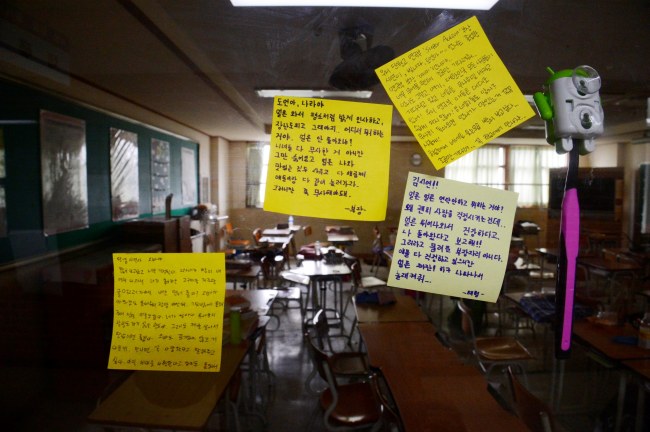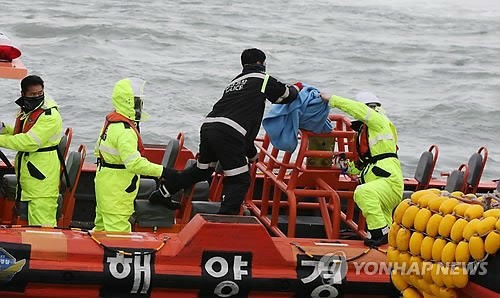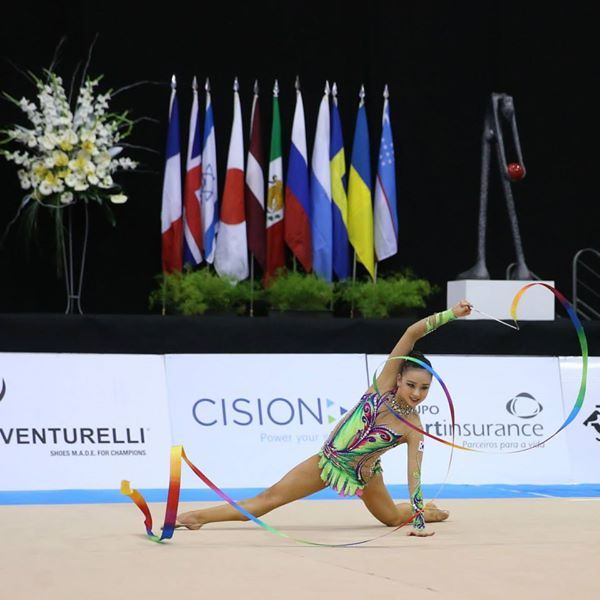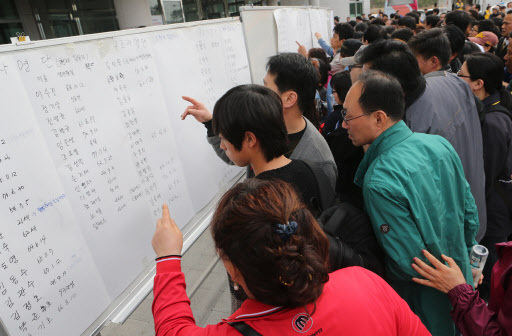 |
| (Yonhap) |
A ferry carrying 475 passengers and crew sank off the coast of Jindo Island in South Jeolla Province on Wednesday, leaving at least nine people dead and hundreds unaccounted for.
The ferry, the 6,325-ton Sewol, began to sink at about 8:55 a.m. off the coast of Jindo on its way to Jejudo Island from Incheon. According to the Ministry of Oceans and Fisheries, however, the Sewol began to drift in an unexpected direction from 8:52 a.m.
Of the people on board, woman identified as 22-year-old Park Ji-young, a staff worker for the ferry company, and five students -- Jung Cha-woong, Kwon Oh-chun, Lim Kyung-bin, Park Sung-bin, Park Young-in -- at Danwon High School in Ansan, Gyeonggi Province, were confirmed dead.
Two other victims had been recently identified as 25-year-old Choi Hye-jeong, and 35-year-old Nam Yoon-chul, teachers of Danwon High School, and a 28-year-old male named Kim Ki-woong, official said.
As of 11 a.m. Thursday, 179 people were rescued and 287 unaccounted for.
The passengers included 324 students and 14 faculty members from Danwon High School who were traveling to Jejudo Island on a school trip.
The government immediately launched a central response center, with President Park Geun-hye ordering authorities to concentrate on rescue efforts.
“Efforts should be made to prevent even one casualty, and a thorough search (of the ship) must be carried out to ensure nobody is left behind,” Park was quoted as saying by Lee Gyeong-og, second vice minister of security and public administration.
The president also visited the central response center and urged the officials to pick up the pace of the rescue operations as sunset was approaching.
The Minister of Security and Public Administration and the chief of the National Emergency Management Agency coordinated the rescue efforts from the scene.
The Navy sent out vessels along with two helicopters. Navy and Coast Guard commandos were set to begin searching inside the vessel from 5 p.m. Along with the Navy and Coast Guard, the Air Force and the Army dispatched aircraft to the scene. The divers were to begin the search starting in shallower areas and then put the underwater search in full swing early Thursday.
In addition, U.S. Navy ship Bonhomme Richard joined the rescue efforts. The U.S. 7th Fleet also said that it would provide support as necessary.
Although the Security Ministry initially claimed that 368 people had been rescued as of 1:10 p.m., the figure was later revealed to have been a miscalculation.
“As the rescue operation is underway, the exact numbers cannot be compiled yet. The figure of 368 (rescued people) was a mistake,” Second Vice Minister Lee said in a special briefing at about 3:30 p.m.
He added that the number is likely larger than the figure of 166 that the ministry had announced earlier in the day.
In addition, the government and Chonghaejin Marine Co., the operator of the sunken ferry, were unable to determine the number of people on board.
The ferry company initially announced that 477 people were on board while the government put the figure at 459. The ferry company later changed the figure to 462. As the government and concerned organizations struggled to pin down the figures, rescue operations continued in difficult conditions.
Rescue workers arrived at the scene at 9:30 a.m., about half an hour after the emergency call from the Sewol, but the search for survivors was hampered by strong currents.
The passengers were initially told to stay put, but began jumping into the sea following an onboard announcement that the ship was about to sink completely as rescue efforts were underway.
With survivors saying that power inside the ship was cut off as it was sinking, it is speculated that many may have been trapped inside.
“A search was conducted within a 5-kilometer radius, but no recoveries were made. Considering the water temperature, depth and the time lapsed, anyone trapped inside is unlikely to have survived,” a rescue worker told a local news network.
The depth of the sea where the ship sank is reported to be over 45 meters, with a reported water temperature of about 12 degrees Celsius.
The cause of the accident was not yet determined by 6 p.m., but the passengers suggested that the ferry hit a reef just before 9 a.m. when the vessel jolted with a loud noise.
Rescued passengers also speculated that thick fog may have contributed to the accident, but the meteorological office said the area was clear with visibility of about 20 kilometers.
It is also speculated that the ferry may have altered course in order to make up for time lost due to its departure being delayed by weather conditions.
Chonghaejin Marine apologized for the accident and vowed to focus on rescue efforts.
A company official said the vessel did not deviate significantly from course, and that the company was making preparations to recover the ferry.
The captain of the Sewol is a veteran with eight years of experience operating the Incheon-Jejudo Island route. The 69-year-old man surnamed Lee joined Chonghaejin Marine in November 2006. He is the most experienced of the three captains operating the company’s large ferries, according to a Chonghaejin employee.
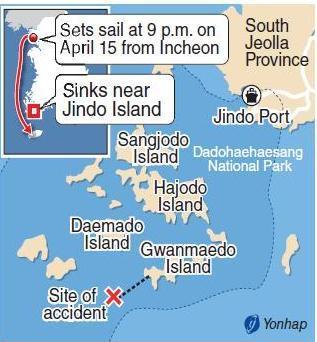
He had been operating a different 6,325-ton ship before he was switched to the Sewol in March 2013.
Lee was sent on the day of the accident to operate the Sewol to fill in for the main captain, who had gone on vacation.
“Lee is a substitute captain, who fills in for the Incheon-Jejudo Island route when the two captains assigned to the route go on vacation,” a Chonghaejin Marine official said. He added that there should be no problem with Lee operating the ship, as qualification for a substitute captain requires approval by the Incheon Regional Maritime Affairs and Port Administration.
The company operates four vessels including the Sewol on three routes ― which set out from either Incheon or Yeosu ― as well as river taxis on the Hangang River.
This is the second accident involving a Chonghaejin Marine vessel to occur in three weeks.
On March 28, another Chonghaejin ferry hit a 7.93-ton fishing boat en route to Baengnyeongdo Island in the West Sea from Incheon. The 396-ton ferry was carrying about 140 passengers and no injuries were reported.
No irregularities were found on the Sewol during a safety check conducted in February.
By Choi He-suk and Suh Ye-seul (
cheesuk@heraldcorp.com) (sys@heraldcorp.com)
